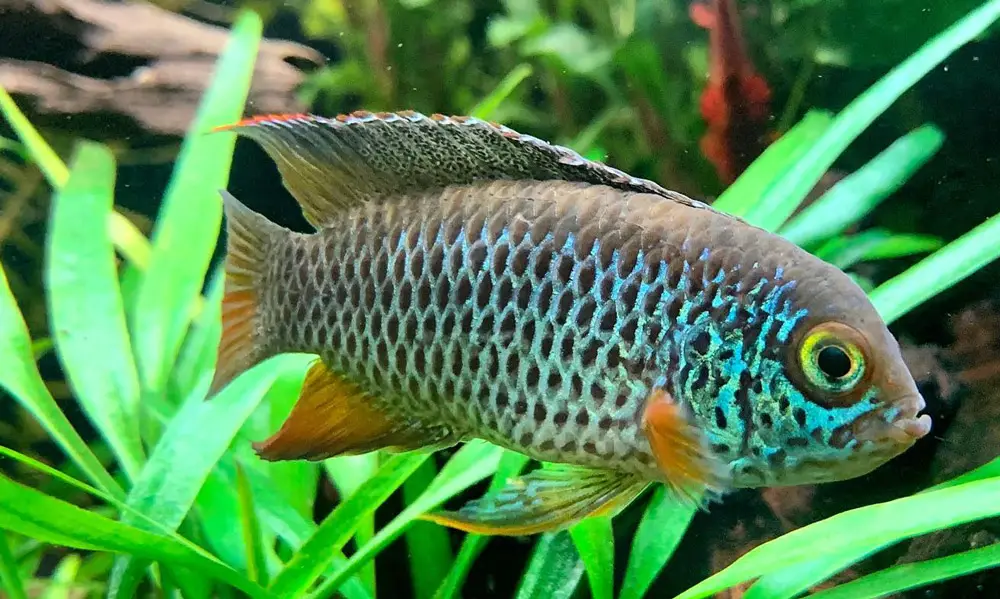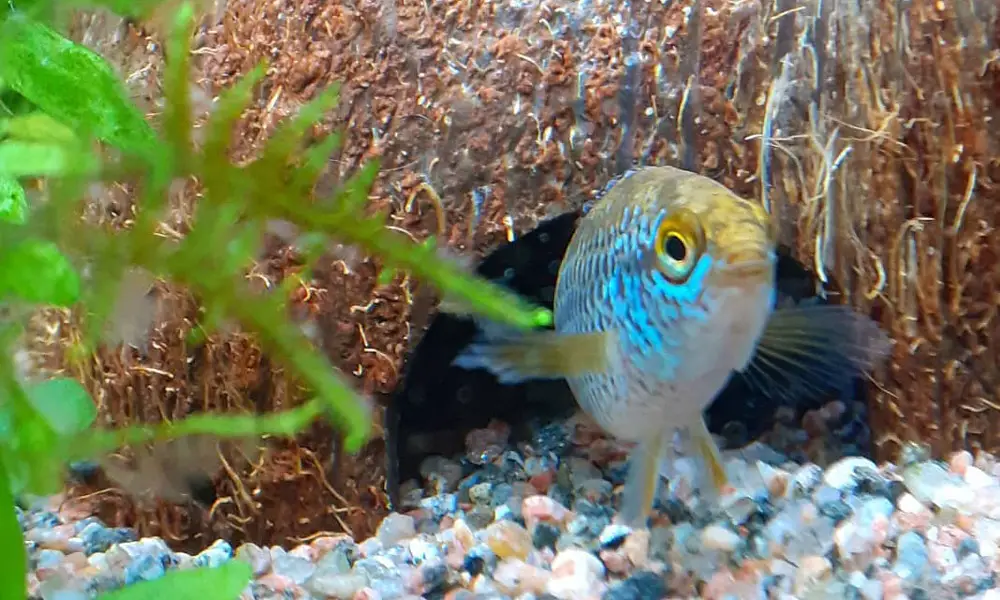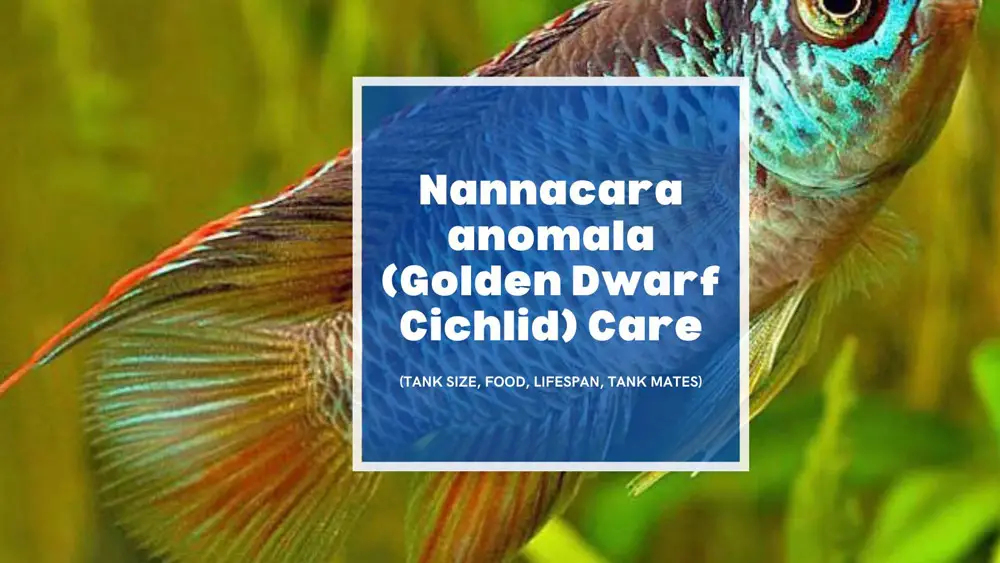South America is home to an incredible diversity of cichlids, including many that can be classified as “dwarf cichlids.” The term is often used to describe smaller cichlids among hobbyists and has no clear definition and scientific basis, but I like to follow a working classification used by cichlid expert Dr. Paul Loiselle, which places dwarf cichlids as one of the sexes reaching a maximum standard length of 4 inches (10 cm) or less.
The golden dwarf cichlid (nannacara anomala) is a perfect example of one of these diminutive cichlids and is a personal favorite of mine. Like the most colorful and inquisitive Apistos (Apistogramma spp.), these little guys may be small in size but have big personalities.
If you’re looking for a very nice little cichlid for your first South America fish tank, we highly recommend the golden dwarf cichlid. Keep reading to learn more about these out-of-the-ordinary creatures!
Species Summary
Also known as goldeneye cichlid, the golden dwarf cichlid (n. anomala) is the most commonly sold species of the genus Nannacara in the aquarium trade. This delicate fish was once quite common among hobbyists, but it has declined in popularity in recent years. While the reasons are unclear, the price has certainly increased.
The genus Nannacara is a small group of freshwater cichlids with only six described species. Going by Dr. Paul Loiselle’s definition, the members of the Nannacara, along with other three genera: Apistogramma, Mikrogeophagus, and Dicrossus, would come under the “dwarf cichlid” group in the hobby.
Nannacara species are endemic to South America, and nannacara anomala is mainly found in the Aruka River in Guyana east to the lower Rio Marowijne in Suriname. In the wild, these fish live in flooded savannas in the low-lying coastal zone.
Breeding n. anomala is pretty straightforward in the home aquarium. (We will discuss more on this later in the article.) Nowadays, most of these fish that can be found in the market are commercially raised in Europe.
| Scientific Name: | Nannacara anomala |
| Common Name: | Goldeneye Cichlid, Golden Dwarf Cichlid |
| Care Level: | Beginner |
| Origin: | South American |
| Lifespan: | 5 to 8 years |
| Max Size: | Male: 3″ (8.9 cm) | Female: 1.5″ (3.8 cm) |
| Temperature: | 72° – 77° F (22° – 25° C) |
| PH: | 6.0 – 7.5 |
| Water hardness: | 0 -10 dGH |
| Diet: | Omnivorous |
| Minimum Tank Size: | 20 gallons |
| Temperament: | Peaceful |
Appearance

The beauty of Golden dwarf cichlids is something that will definitely feast your eyes! They are one of the most beautiful freshwater fishes with a unique color pattern.
These fish have a honey-gold with iridescent blue-green sheen all over. Their fins are transparent with a hint of yellow. They also have large golden eyes, from which they get their common name.
Males Vs. Females
As youngsters, both sexes look very similar. The only way to tell the difference would be an extension at the back of the dorsal fin in males.
However, as they grow older and reach sexual maturity (at about an inch long), the males tend to be a bit larger and more colorful than females, often showing bright electric blue on the head and flanks. They also have longer, pointed fins and may have red and orange coloration.
Females, on the other hand, are typically a duller yellow color with a black line running along the flanks. But they will present an attractive checkerboard pattern when ready to spawn.
Lifespan
The average nannacara anomala lifespan is between five and eight years. Their lifespan can vary depending on the quality of their environment and diet.
To ensure a long and healthy life for your fish, it is important to provide them with a clean and well-maintained aquarium. It is also crucial to feed them a nutritious diet.
Size & Growth Rate
At full maturity, male golden dwarf cichlids grow to a maximum length of 3 inches (8.9 cm), while females are a bit smaller and only reach 1.5 inches (3.8 cm). These fish take about 6 to 10 months to become sexually mature.
Virtually a fish’s growth rate and potential size can be traced to a stress-free environment, a varied diet of high-quality foods, and improper water conditions, no matter how hardy they might be.
Author note: Since most of the golden dwarf cichlids are captive bred now, the genetics of the breeding strains will play a role in the lifespan and growth rate of your fish. Always purchasing from a reputable breeder or dealer will guarantee you get a fish that is less likely to succumb to genetic problems.
Golden Dwarf Cichlid Care
In their natural habitat, golden dwarf cichlids inhabit soft, acidic, slow-moving water bodies with abundant aquatic plants, making them a good choice for a centerpiece or showstopper fish in medium-sized planted aquariums.
Because they have been tank bred for many years, they are extremely hardy and quite adaptable to their demands. That being said, they will thrive and display their best coloration and behavior in an aquarium that closely resembles their natural habitat.
Nannacara anomala Tank Size
Unlike these large South American Cichlids, they don’t need a tank the size of your living room. Generally, a trio or a pair of Nannacara anomala can be housed in a 20-gallon planted aquarium (30″ x 12″ x 12″).
Of course, you must go bigger if you want to keep them with other fishes or have a more diverse planted setup. Female nannacara anomala tends to be nasty when protecting fry.
Furthermore, the larger the tank, the easier it is to maintain water quality and stability. Personally, I prefer to go with a 33-gallon long aquarium for these dwarf cichlids, which allows me more room to work with in terms of aquascaping and fish stocking.
Water Conditions
Golden dwarf cichlids are very adaptable and hardy when it comes to water parameters. This means you have a pretty wide range of parameters you can work with and still be successful.
Of course, it’s best to mimic the water conditions of their natural habitat if you intend to breed them. But for the average hobbyist, here are some ideal water parameters to aim for:
- Temperature: 72° – 77° F (22° – 25° C)
- PH: 6.0 – 7.5 (Aim for the lower part of the range)
- Hardness: 0 – 10 KH
You need to stay on top of your water quality with regular water changes and a good filtration system. A word of caution, these fish are sensitive to large volumes, so a turnover of about 2-3 times the volume of your tank per hour is sufficient, but you need to consider the bioload and what other fishes you have in the tank.
Decor

To create a stress-free environment that feels natural and comfortable for your fish, you can use a sandy substrate and plenty of live plants. Nannacara anomala love to hide among the dense foliage, so make sure you have plenty of plants with bits of bogwood or driftwood. Java moss, java fern, cryptocoryne wendtii, and dwarf sagittaria are all good choices.
Not only do plants and driftwood provide plenty of shelters for the male and other females to hide, but they also help with water quality by absorbing excess nutrients. A well-planted aquarium is also living art that creates a beautiful natural scene in your home.
Food & Diet
In the wild, golden dwarf cichlids are micro predators. They feed mainly on worms, insects, and other invertebrates.
Wild-caught specimens may hard to accept aquarium fish food in the aquarium, but they can be taught to take dry foods. A meaty Cichlid pellet makes a good base for their diet, supplemented with live or frozen foods such as Daphnia, brine shrimp, and bloodworms. Some vegetable matter is also necessary.
[amazon box=”B001AEOX7G”]Don’t try to get a fish that used to only eat live foods to switch to pellets or flakes right away, as this typically doesn’t work, and the fish just starves. Start by offering live/frozen food, then slowly process to freeze-dried food, and finally pellets or flakes.
I always feed these wild caught individuals a mix of frozen and flake food. The variety and patience really pay off.
Nannacara anomala Tank Mates
As we’ve mentioned earlier, Nannacara anomala is peaceful, but breeding females are the exception to the rule. They can become very aggressive and nasty toward any fish when guarding their eggs and fry, especially the male anomala.
Because of this, you may have problems if they start breeding in a community tank. It’s best to move them to their own breeding tank or keep a pair in a small species-only tank.
These attractive little fish are cute and do make an excellent breeding project for the beginning hobbyist who wants to walk through the spawning stages of cichlid.
In a large enough aquarium, you can keep them with a variety of peaceful tank mates. Always keep a close eye on aggression from the female when she is ready to spawn.
Nannacara anomala Breeding
Breeding this Nannacara anomala is fairly easy. This species has been reproduced in captivity for years. However, you have to provide them with the right water conditions and a good diet to promote spawning.
It’s best to keep a pair in a separate tank that has at least 15 gallons. The breeding tank should be under the same water conditions we mentioned above.
Most importantly, you must provide hiding places for the male anomala to hide, as well as suitable caves for the female to lay her eggs in. These cichlid caves and flower pots will work.
You might be interested in reading our article: 7 DIY Aquarium Caves Ideas (Functional and Natural-Looking)
To initiate spawning, you can slightly lower the water level in the tank and raise the temperature to the top of their recommended range.
The female will lay up to 300 eggs in the cave. After she lays the eggs, the male will fertilize them, and then the female takes sole responsibility for guarding and caring for the eggs. At this time, the female becomes very aggressive and will defend the eggs with her life.
In small tanks, the male anomala should be removed, and sometimes the female may kill him. As long as you have plenty of hiding spots for the male to hide when the female is brooding fry, he can be kept in the same tank. That’s why some owners wouldn’t describe N.anomala as pair breeders.
But I still suggest breeding these fish as pairs because of an interesting behavior that I’ve seen from these cichlids. Once upon a time, the female died after successfully spawning fry. The male didn’t go away; instead, he took on the duty of caring for the fry, and to my surprise, he developed the same brood pattern as the female, though in a paler version.
The eggs will hatch in 2-3 days, and you may notice that the female often moves the fry to a shallow depression that she has dug on the substrate. The fry will be free-swimming a week later.
Wrapping Up
Nannacara anomala is an attractive cichlid that makes a great addition to small planted aquariums. They are easy to care for and breed, making them perfect for beginners.
Keep in mind that the female can become quite aggressive when she is spawning and protecting her fry.
As always, send us your questions or thoughts in the comments below. We’ll be happy to lend a hand.
